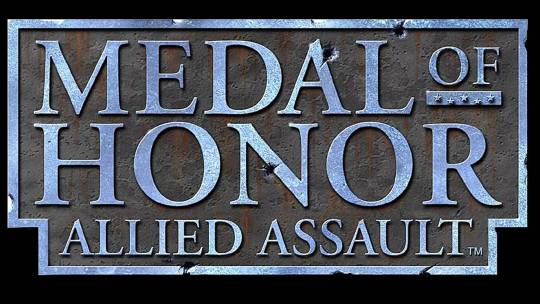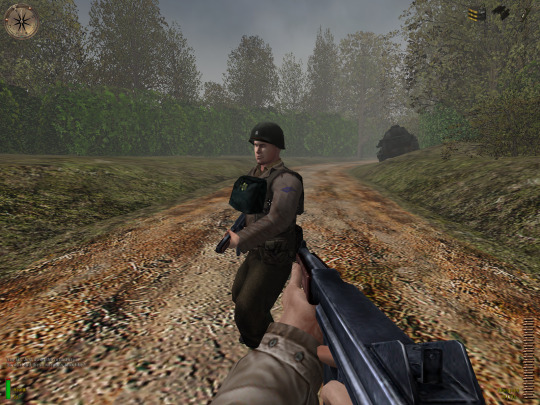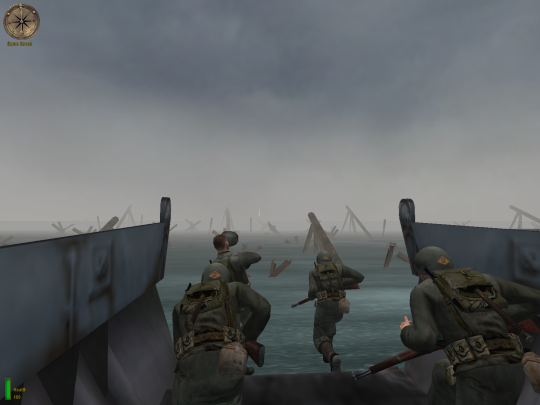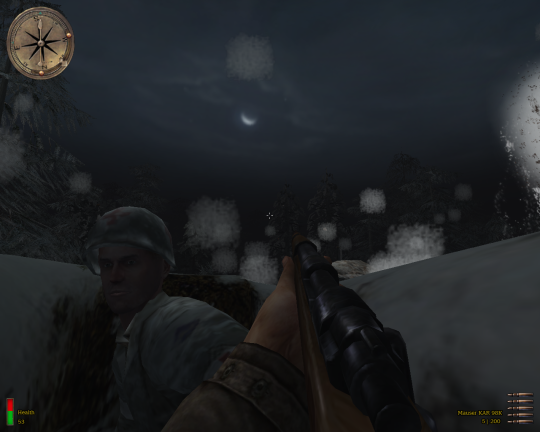Medal of Honor: Allied Assault, or MOHAA; the first game in the series to be developed for and released exclusively on the PC (and Mac computers, but who cares); the game I so shunned when I first got my youthful hands on it, the game I unwisely compared to Call of Duty, the game I found too boring to play through.
Allied Assault was developed by 2015, Inc, who also developed the Men of Valor games and members of which eventually founded Infinity Ward. It launched to universal acclaim, sitting at a comfortable 91.05% at Gamerankings and 91% on Metacritic. By 2006, it had sold over 30 million copies and it was the 9th best-selling videogame in the United States, between 2002 and 2006.
 | |
In many ways, Allied Assault is a soft-remake of the original title. Once again, the player takes the role of an OSS agent, this time Lieutenant Mike Powell. Much like Patterson, Powell is a lone wolf protagonist, usually behind enemy lines, partaking in a variety of missions starting from Africa to France and Germany.
Playing MOHAA in this day and age, over 15 years after it was originally released, is both a satisfying and a trying experience. The campaign is meaty, but doesn’t overstay its welcome and despite the “lone wolf” direction, the power of the modified idTech 3 engine allows for large maps, more enemies on screen and even friendlies for a lot of missions.
The game is pretty enough (considering its age) and the soundtrack still manages to create the illusion of partaking in a grand Hollywood WWII epic. It’s keeping nicely with the series’ film roots, especially since there are missions, locations and even characters in the game, inspired from Saving Private Ryan.
The most satisfying thing about MOHAA is the gunplay. All the weapons feel both powerful and authentic. The version of idTech 3 the studio used to develop Allied Assault was the heavily modified version used for the game Heavy Metal: F.A.K.K.² , but the original engine was used for Return To Castle Wolfenstein. Playing both that game and MOHAA is an eye-opener, when it comes to how much work 2015, Inc (and Ritual Entertainment before them) put into making the game both fun and authentic. Return to Castle Wolfenstein is a really fun game on its own, but the weapons are a little bit floaty and hit detection is all over the place. MOHAA, by comparison, feels good; accurate and polished, you feel every bullet you fire and gameplay feels more satisfying.
Allied Assault, in general, manages to skirt the line between the traditional hero power-fantasy and the realism of being a WWII soldier. The game registers damage based on which part of the model is shot, but the enemies are still bullet-sponges. So, despite the historically-faithful presentation, the hero still carries an entire arsenal of all kinds of weapons on him, despite the fact that in real life, anything more than one rifle and maybe a side-arm, a grenade and two ammo clips would’ve seriously impeded his ability to move efficiently. Likewise, headshots drop enemies faster, but sometimes a single shot can knock their helmets off without killing them; a cute detail, but no helmet would deflect a 7.76mm bullet from a rifle; helmets are primarily worn for protection from either small arms fire or grenade fragments. What I’m saying is that MOHAA predates the pretense of “realism” in games, which went mainstream in the military shooter subgenre with games like Modern Warfare. It remembers it needs to be a fun game just as much as it remembers it needs to be loyal and respectful to its subject matter.
 |
Captain Ramsey, modelled after Captain John Miller from “Saving Private Ryan”, down to the voice actor mimicking Tom Hanks.
The AI is where things start getting hairy with MOHAA. Enemies use basic tactics, dodging, rolling, crouching and so on, but it’s all very inconsistent. Sometimes they just waltz into the line of fire, while other times they have 100%, pinpoint accuracy blind-firing with a SMG. We’re talking about enemy AI in a 2002 game, which means it’s hard to fault 2015, Inc for it. Additionally and returning to Return to Castle Wolfenstein, that game has the exact same problem, only a lot worse. I don’t know if it’s an engine problem, but between the two games, the AI in MOHAA is indeed a lot more versatile and impressive, for its time, by comparison.
For the modern player, unfortunately, it’s very easy to see how scripted enemy AI is in MOHAA; enemies spawn out of nowhere, their accuracy improves exponentially as the game progresses and a lot of the challenge relies on knowing exactly where enemies are beforehand. Unfortunately, this means a lot of the game becomes trial-and-error; enter a new area, get riddled with bullets, memorize enemy positions, reload, shoot them the second you enter their field of vision. MOHAA has really good pacing by design, but its approach to challenging gameplay breaks flow. There is very little depth in gameplay and the player is stripped off of any tools outside quick-save/quick-load to deal with the rising challenges.
Frustrating moments in the game include the Omaha Beach landing, which is designed to get the player hit, which is a problem if there are no hit-points to spare; infiltrating a mansion to recover documents triggers an alarm even if the player hasn’t been discovered, simply because that’s the mission design; a drudge through a French town with countless German snipers posted, who get perfect shots in from all directions giving no recovery time to the player.
Friendly AI is also a pain; in the aforementioned mission in France, the player has to escort a tank crew to steal a King Tiger tank. The town is filled with enemies and the friendly NPCs are nearly useless in defending themselves; they need to be baby-sat. Unlike games like Call of Duty, essential NPCs aren’t immortal in MOHAA and if they die, the mission is a failure. This part of the mission took me over 20 minutes of real-time to complete, because the tank crew would get themselves killed all the time.
The final mission is also a good example of scripted progress; the last part is a 5-second-long-run, but it takes a lot of retries, because the player is ambushed by enemies upon exiting the last objective to escape on a train filled with US Rangers; he Rangers won’t open the door until some time has passed, even though the train is already there and waiting.
 |
One of gaming’s most famous levels; “Operation Overlord”, the invasion of Omaha Beach on June 6, 1944.
MOHAA spawned two expansions, Spearhead and Breakthrough, developed by EA Los Angeles (the re-branded Dreamworks Interactive) and TKO Software, respectively. Neither expansion brings anything new to the table in terms of mechanics, but they take a different direction to the core game. There is a bigger focus on large set-pieces, big, wide battlefields (to the extend the engine allows) and comrades-in-arms that accompany the player. Both still feature a defined protagonist (and the Spearhead protagonist even has a voice during inbetween-mission cutscenes), but they are no longer special OSS agents; they’re both regular soldiers in the front lines.
Spearhead is extremely short, but the departure from the MOHAA norm is as clear as the opening mission that drops the player with a parachute in Europe during the last days of the war and includes blowing up bridges and taking down tanks single-handedly with sticky bombs; several times. Breakthrough is meatier; it has more variety in locations, from Tunisia to Italy and it combines the traditional MOH mission design with Spearhead’s more cinematic and noisy set-pieces. Where Spearhead is straight-forward action, Breakthrough includes sabotage and infiltration missions, as well as big battlefield shoot-outs.
They both suffer from the same problems as the base game; MOHAA is a great corridor shooter, but the moment it employs more complicated mechanics and levels, it falls apart. So, enemy AI is still all over the place, only in the expansions there is a lot more of it to deal with. Friendly AI is still a liability, when NPCs have to be baby-sat. Vehicle segments lack the polish of other military shooters and become too chaotic and hard to follow. Much like with MOHAA-proper, expansions rely on learning how to use quick-save/quick-load and memorize enemy positions all the time, instead of organically moving through levels with the necessary recovery time (and tools) to deal with the situations and challenges that arise. Additionally and for reasons I can’t even begin to fathom, Breakthrough is very stringy with ammo; enemies rarely drop their weapons upon death and often players will find themselves praying for an ammo clip before the next enemy encounter.
Having said that, Breakthrough is a good addition to the base game; the variety it offers in locations adds quite a bit to the original that takes place primarily in France and the expansion in itself has good pacing and good mission structure. The gunplay is still just as fun and despite the problems inherent with the entire game whenever it opens up, some sequences in busy battlefields are both impressive and a nice contrast to the more conservative base game.
Spearhead is more than a little disappointing for a lot of reasons, not the least of which is the fact that it was developed by the people who created the series in the first place. The base game has the best level design among the three, but Spearhead, in particular, is a disaster in that regard. It feels slow, it’s not very impressive, it doesn’t have good flow and a lot of it feels more like EA Los Angeles’ original pitch for the first Call of Duty, than a proper, full-fledged expansion for Allied Assault.
 |
“Spearhead” adds more variety to the traditional “lone wolf” MoH design and resembles early “Call of Duty” a lot more than the base game.
MOHAA is a product of its time. I’ve detailed my issues and frustrations with it, because those tend to stick out, but for every one of them described above, there are legitimately fun moments too; walking around Nazi soldiers flashing security papers, infiltrating and blowing up a German submarine, walking through a French town and picking enemies off door-to-door, slowly progressing through the French countryside to take down 88mm guns with explosives; even without the impressive set-pieces of its competitors, MOHAA shows what good gun mechanics and proper pacing can provide to the player.
The WWII genre is bound to see a resurgence soon; at the time of writing this, the next Call of Duty title will revisit that setting with the upcoming Call of Duty: WWII, but unfortunately that series has long departed from its original installment’s design tropes. For someone less interested in hand-holding, massive set-pieces and generic soldier storylines out of Direct-To-Video movies, MOHAA holds up well enough. It has its problems but the shooting is as good as anything and the campaign takes but a few hours to complete. I’d only recommend playing on Easy; first impressions won’t be good, but it will help with the frustrations after the difficulty spikes around the end of the first mission.
MOHAA was lauded for its gunplay and realism back in the day; the truth is, that realism existed only as a departure from the FPS norm at the time, which focused almost exclusively on aliens or demons or space-marines and so on. No realistic war setting would have one man take down five dozen German soldiers by lunchtime on his own, something that sadly even Call of Duty failed to realize as early as its second game. But it’s maybe because of the dated design and traditional mechanics that I’d argue MOHAA is more enjoyable, nowadays, than Call of Duty 2. It’s a lot harder to buy some random soldier of one of three nationalities tearing through scores of Nazis than it is for a defined protagonist whose job is to be the elite of the elite in an elite military branch. Mike Powell, like Jimmy Patterson before him, isn’t quite Solid Snake; but he’s supposed to be good enough that the framework of MOHAA makes suspension of disbelief easier. The presentation of the game, the Hollywood-esque visuals and music, help circumvent the ludonarrative dissonance that one can experience in a pseudo-realistic shooter like Call of Duty 2. The second installment in Infinity Ward’s series is too loud and hectic to convince the player that what they’re fighting is a capable war machine, instead of targets in a shooting gallery. MOHAA, on the other hand, is paced perfectly and it’s not until you recount the experience that you see the logical cracks in it.
There is a return to form for the entire FPS genre lately, but outside of the new Wolfenstein games, corridor shooters are still out of fashion, as most titles adopt the “arena” type of level design (Serious Sam, Shadow Warrior, DOOM). If you miss that more traditional approach and you think you can deal with the frustrations inherent in a game of its age, Medal of Honor: Allied Assault is still a lot of fun and deserves a playthrough; and if you’ve finished the game before, it’s as good a time as any to go back and see how it holds up for yourselves.
No comments:
Post a Comment